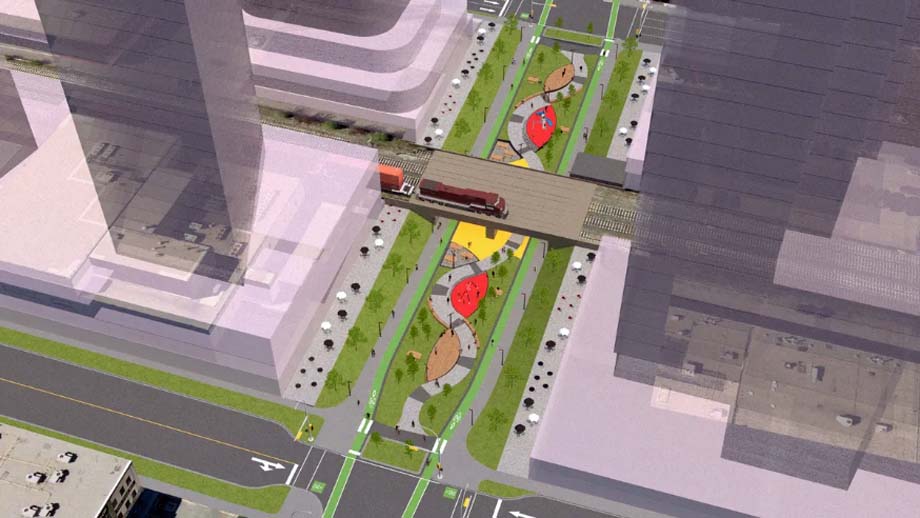
Calgary Alberta - Calgary is proposing to shut down a busy stretch of roadway on the edges of its
downtown and build an underpass beneath a railway crossing to create an area for pedestrians and
cyclists.
The transformation of a level railway crossing that links the downtown core with the Beltline neighbourhood to the
south would be a significant departure in a city that has a reputation for prioritizing cars.
It is also part of a trend away from vehicle-dominant urban planning in Canada.
The project to bypass the Canadian Pacific Railway at 11 Street SW entered the final stage of consideration in June as
city planners proposed a reduced traffic and a car free option to residents.
The planners said they favoured the car free proposal.
"This project is really looking at the future of this connection in the west end of Calgary," said Shane
LeBouthillier, a project manager and senior engineer with the city's transportation department.
Mr. LeBouthillier said the 11 Street SW project is important because it is the last crossing in the city where the
railroad tracks are at ground level instead of elevated or buried.
At such crossings, cars and pedestrians can't get to the other side while a train is passing, said Mr. LeBouthillier,
adding that this causes congestion because the city is heavily dependent on private forms of
transportation.
Public consultation on the options for the underpass, a road with less room for traffic than before, or an outdoor
walkway with greenery and dedicated bike paths, closed on 29 Jun 2022 with the final phase of negotiations to begin
after the long weekend.
Duelling opinions over how cities should accommodate cars, cyclists, and pedestrians have shaped municipal politics
across North America over the past decade, but the debate has become more common in the COVID-19 pandemic as the
explosion of outdoor patios and the expansion of active transportation networks eat into existing
roadways.
Peter Oliver, president of the Beltline Neighbourhoods Association, an organization of local homeowners that has
advocated for a driverless version of the crossing, said that despite some initial resistance, people are generally
warming up to the idea of reimagining Calgary's urban spaces to be more pedestrian friendly.
"I think it's been acknowledged that there needs to be more consideration for how people can use transit to get
around within the greater downtown as opposed to just these sort of routes that are sort of more hub and spoke just
taking everyone from one corner of the city to the downtown," Mr. Oliver said.
Although undecided on which of the two options he prefers, Beltline councillor Terry Wong said he supports making
Calgary's downtown more accessible for pedestrians and cyclists.
Mr. Wong, who recently spent time in Toronto, said "there are some things to be learned" by examining the
walkability and freedom of movement that pedestrians have in other Canadian cities that could be applied to Calgary's
downtown.
"At the end of the day I think, you know, people enjoy the vibrancy of what Toronto brings," he
said.
"Being able to go to retail stores, restaurants, pubs, and walk through the streets without having to worry about
a lot of cars on the road."
Toronto has in recent years adopted pedestrian-friendly initiatives.
The King Street Transit Priority Corridor essentially bans most cars from driving on the busiest stretch of the street
during peak hours, making way for pedestrians, cyclists, and streetcars.
Its ActiveTO program, introduced at the beginning of the pandemic, converts major high-speed traffic arteries into bike
and pedestrian-only zones on weekends.
According to Bev Sandalack, a professor specializing in urban design at the University of Calgary, cities such as
Toronto have the advantage of being designed to contend with features like hills and slopes.
Many of the problems in Calgary, which is built on flat plains, lie in its grid-like design that favours fast-moving
traffic over walkable streets, along with its construction around a railway that has been at the city's heart for more
than 100 years.
Rather than simply reimagining how to cross the rail line, Prof. Sandalack believes the rail line itself needs to be
dealt with, citing the potential for a major accident like a derailment involving hazardous or explosive cargo in the
city's centre.
"I think it may take something like an accident, a derailment, an oil spill, something really, really,
catastrophic, to get people to think that it is really not a good idea to have heavy rail going through the
downtown," Prof. Sandalack said, noting that trains pass through several times a day.
Based on her experiences visiting Oslo, Norway, where local governments buried a downtown railway, Prof. Sandalack said
she wishes Calgary would put the line underground, an idea proposed in 2016.
"It's just a matter of how you prioritize things," she said.
Criticisms aside, Prof. Sandalack is optimistic that the general trend in Canada is toward an increased focus on things
such as cycling infrastructure and accessible experiences for pedestrians, which she says is key to making livable
urban spaces that will last.
"I think people generally know what's best, from an urban design point of view," she
said.
Jake Kivanc.
(likely no image with original article)
(usually because it's been seen before)
provisions in Section 29 of the
Canadian Copyright Modernization Act.
